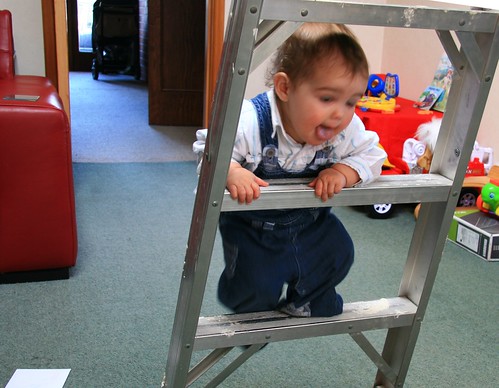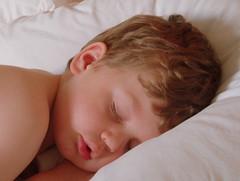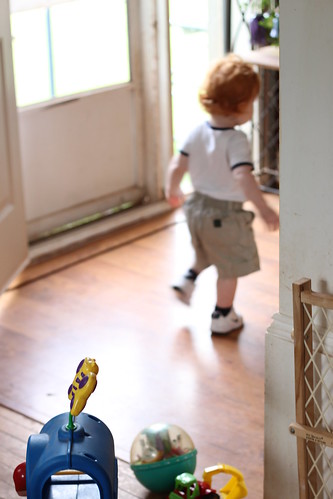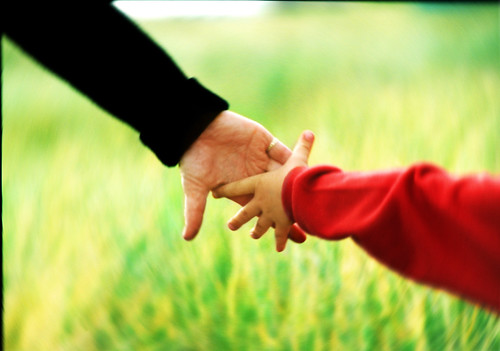Update: This is the fifth in a ten part series on gentle effective ways to discipline young children. If your child is in childcare, or you’ve ever had the pleasure of visiting or participating in a parent/infant class, you may have found yourself wondering how it’s possible that groups of six or eight young toddlers can co-operate so well, and play so peacefully and contentedly, with a minimum of direction from adults. Often, one of the things that allows young children to succeed in co-operating so easily in a play group or a quality childcare setting is that the environment is set up to support their success. Any experienced caregiver or teacher knows that a carefully prepared environment goes a long way to help define the “rules” and “limits” for children, thus making it easier for everyone to know what to expect, and to relax and enjoy each other more, without the need for adults to do a lot of “correcting” of children.
The family I’ve been working with for the past five years found me through a nanny agency. In order to qualify to be listed with the agency, I had to go through an extensive application and interview process that included answering a number of questions about how I’d handle different situations that commonly arise when taking care of young children. One of the questions was as follows: What would you do if the two year old you were caring for drew on the walls with a crayon? My answer was that if the two year old I was caring for had drawn on the wall, it would be a clear indication that I wasn’t doing my job well. I went on to explain that I thought it was unreasonable to expect a two year old to know or consistently remember that drawing on the walls wasn’t acceptable, and part of my job as a nanny was to create a environment that allowed a child to play freely, without a lot of restrictions. So, crayons would be kept where a two year old couldn’t reach them, and if crayons were going to be used, I would cover a large surface with butcher block paper, and be close by to observe, in case a gentle reminder was needed to help the child remember to color only on the paper. Sometime after I’d been hired, Vicki ( Mom of S. and J.) told me when she was reading through candidate profiles and she saw my answer to this question, she said to herself, “That’s the person I want to take care of my baby.”
Our instinct as parents is to say, “Oh no, don’t do that”, when our toddler surprises us by suddenly being able to reach or climb to something “out of bounds”. But our children’s abilities are developing daily and we don’t want to discourage them. Remembering to say, “Wow, you can reach that now!” Or, “Look at the leaf you found,” before saying, “but this isn’t safe for you to touch (or put in your mouth). I’m going to move it”, encourages our baby to continue following his healthy instinct to explore. – Janet Lansbury
Consider this: All behavior has a reason and a message. Young children are naturally curious and creative, and they love to experiment. They learn through their play! Sometimes what adults see as destructive or unsafe behavior is simply a child experimenting, or “not knowing.” If we understand this, we can create an environment that allows children to be children and to explore and experiment without being “bad” or wrong.
Try to take some time each day to just observe and contemplate your child. What is going well? What is difficult? What is she especially interested in right now? Is she throwing all of her toys? Has she got an excess of energy? Is she resisting EVERY time a transition takes place? Is she getting into things you don’t want her to and making a mess? Is she taking out all of her toys, strewing them all over, and then saying, “Mommy clean it up ?”
Ask yourself what your toddler’s behavior seems to be saying she most needs and is most interested in, and use your environment to help you give your child clear messages about what behavior is expected and accepted, without having to constantly say “No,” or redirect her.
Ideas for accomplishing this: First, make sure your home environment is safe. How safe is safe? I love Magda Gerber’s definition: Your home ( or at least your child’s play space) should be so safe, that should you get locked out for an hour while your child is inside, when you return, you may find her wet, hungry, tired, or upset – but physically unharmed, beyond a minor scratch or two. One of the easiest ways to make your home safe is to install gates to the doorway of any room, (or set of stairs) you don’t want your child to enter without you. If possible, you might consider creating a safe play space both indoors and out, and create a routine from early on of spending some time just being with your baby in her play space everyday. (A little baby who is not yet mobile only needs a small space like a pack and play.)

It goes without saying that your presence and attention is also needed to keep your little one safe- thus the emphasis on taking unhurried time to just enjoy watching her at play every day, and using the information and clues you gather to adjust your environment to further meet her changing needs.
Creating a safe play space in your home for your baby not only allows her to have a space that is all her own, where there are very few restrictions, but it allows you to take care of some of your needs and get some chores done too- without resorting to turning on the television to entertain her, confining her to a chair, bringing her into the bathroom while you brush your teeth, or into the kitchen while you are cooking.
Here are examples of ways to adjust your child’s play environment to help meet her needs and make it easier for her to succeed in co-operating: If she’s got a lot of energy, make sure she has push and pull toys to use, as well as a simple climbing slide that can be used indoors or out ( Little Tykes makes a good, solid, inexpensive one). Give her empty cardboard boxes to climb in and out of, balls to chase, and big, but not necessarily heavy objects to move around, such as a plastic step stool, big pillows, and empty 5 gallon water bottles.
If she’s throwing all of her toys, put away hard toys, and leave out soft toys, dolls, blankets, stuffed animals, and buy a Nerf basketball hoop. Buy baskets ( 99 Cent Stores are a great place to find these ) or use laundry baskets for her to toss balls into. Baskets and plastic containers are also great for filling and dumping, AND they make cleaning up and sorting toys a breeze as well, while providing yet another activity your toddler will love.
If every transition brings on a temper tantrum, ask yourself if your child is hungry, tired or getting sick. Perhaps she needs more quiet time playing at home, just messing around, and less time in structured activities? Blowing bubbles, water play, sand play, play dough, and shaving cream “art” tend to be very soothing for toddlers, (as long as they are past the stage of putting everything into their mouths). You can fill low, deep containers (think: plastic, under the bed storage containers) with rice and add scoops and cups for another soothing activity – this works indoors as well as outdoors. It’s easy to clean up, and if you buy a container with a top, you can save the rice, and use it again and again. (I have become very creative since moving back to MA where the weather is miserable a lot of the time, and it’s not possible to spend 12 of 24 hours outside most days, as it is in California!)
If your toddler resists cleaning up, maybe you’ve got too many toys out and you need to put some of them away and rotate them. If he’s getting into things you don’t want him to, put them away out of sight and out of reach, under lock and key if necessary.You are getting the idea , I’m sure. There is so much you can do to make your job as a parent easier, while meeting your child’s needs, and gently helping her to succeed in gaining the independence and judgment she needs to be able to make good choices.
Have you found ways to use your home environment to support your child’s natural creativity and curiosity, while helping her to understand and accept limits and boundaries? I’d love it if you’d share your ideas here.
Tomorrow, how to talk so your child can listen!






